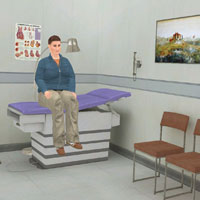Intramural Research and Virtual Reality at the NIH

Susan Persky
Most psychological scientists are well aware of the National Institutes of Health’s (NIH) role as a major grant funding institution, but few know the details of the major research effort that goes on within its walls. The NIH Intramural Research Program directly employs and funds thousands of scientists and fellows to conduct research that contributes to health enhancement and disease reduction. Psychological and behavioral scientists are among these intramural researchers; they are distributed across several of the 27 institutes and centers that comprise the NIH.
The Social and Behavioral Research Branch (SBRB), part of the National Human Genome Research Institute, has one of the largest intramural behavioral-science research programs within the NIH. The branch is comprised of six faculty members, several pre- and post-doctoral fellows, and professional research staff. Some have backgrounds in psychological science, while others have backgrounds in disciplines such as epidemiology, public health, public policy, and health services. The primary goal of SBRB researchers is to investigate social and behavioral factors that influence the translation of genetic and genomic discoveries that have the potential to improve clinical care, prevent disease, and reduce health disparities. Beyond our commitment to this goal, we are also challenged to conduct research that is high risk, high reward, and potentially high impact.
To contribute to this charge, I joined the SBRB in 2005 and founded the Immersive Virtual Environment Testing Area (IVETA). The IVETA is a behavioral research lab located within the NIH Clinical Research Center. Its purpose is to apply virtual reality-enabled methods to explore the social and clinical ramifications of new genetic and genomic developments. We also aim to find ways of translating genetic discoveries to improve clinical care and public health.
Because our research lies in the rapidly developing area of genetics, the ability to be future-focused is particularly important. Only by anticipating the effects of upcoming scientific and clinical advances can we shape their deployment. Applying virtual-reality research methods to investigate psychological and behavioral factors in health and health care is still relatively rare. However, virtual-reality scenarios give us a test platform upon which to conduct research in which participants directly experience and respond to situations that are expected to occur in the future, but may not yet be a reality. For example, we can assess how integrating genomics-based obesity risk information into a medical visit impacts the beliefs and behaviors of doctors and/or patients.

A scene from a virtual-reality scenario in which volunteer interact with an obese patient.
Indeed, much of the research we perform in the IVETA involves simulated clinical encounters between a virtual health care provider and an actual patient, or a virtual patient and an actual health care provider. Some of my research in this vein, performed in collaboration with Collette Eccleston, investigated how providing information about genetic underpinnings of obesity to medical students impacted the care and treatment of a (virtual) patient. Our findings suggested that obesity genetics information can partially decrease medical students’ stigmatization of an overweight patient; however, it may also result in reduced counseling and care related to dietary and physical activity behavior. In current projects, my collaborators and I attempt to identify strategies for communicating genetic information related to obesity and other health conditions such that it results in decreased stigmatization, but also encourages treatment decisions that lead to health-promoting behavior among patients.

A lab member demonstrates virtual reality gear worn by study participants.
Research in the IVETA has also employed virtual reality to create opportunities for precise and controlled measurement of participant behavior. For example, in collaboration with Colleen McBride, Chief of the Social and Behavioral Research Branch, we are using a virtual reality model of a buffet restaurant to investigate how provision of genomic information about a young child’s obesity risk affects mothers’ food choices for that child. In projects like this one, we perform lab studies that elucidate the impact of genomic risk information provision on the kind of behaviors that occur in daily life and community settings. Therefore, we bring experimental, psychological studies a step closer to informing public health practice.
The IVETA and the investigations conducted within it represent just one example of how psychological scientists in the NIH Intramural Research Program apply psychological methods and theories to conduct leading-edge research. Psychological scientists within the NIH study a variety of diseases and conditions using a variety of approaches in varying interdisciplinary environments. However, we all have the shared goal of applying our research to improve human health.





APS regularly opens certain online articles for discussion on our website. Effective February 2021, you must be a logged-in APS member to post comments. By posting a comment, you agree to our Community Guidelines and the display of your profile information, including your name and affiliation. Any opinions, findings, conclusions, or recommendations present in article comments are those of the writers and do not necessarily reflect the views of APS or the article’s author. For more information, please see our Community Guidelines.
Please login with your APS account to comment.